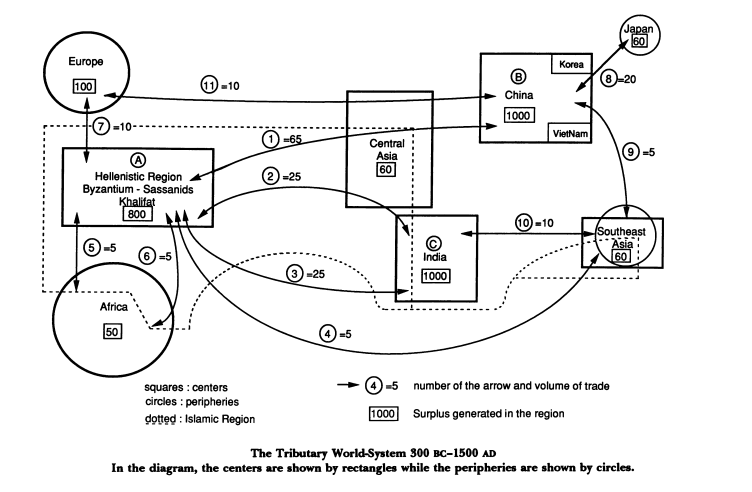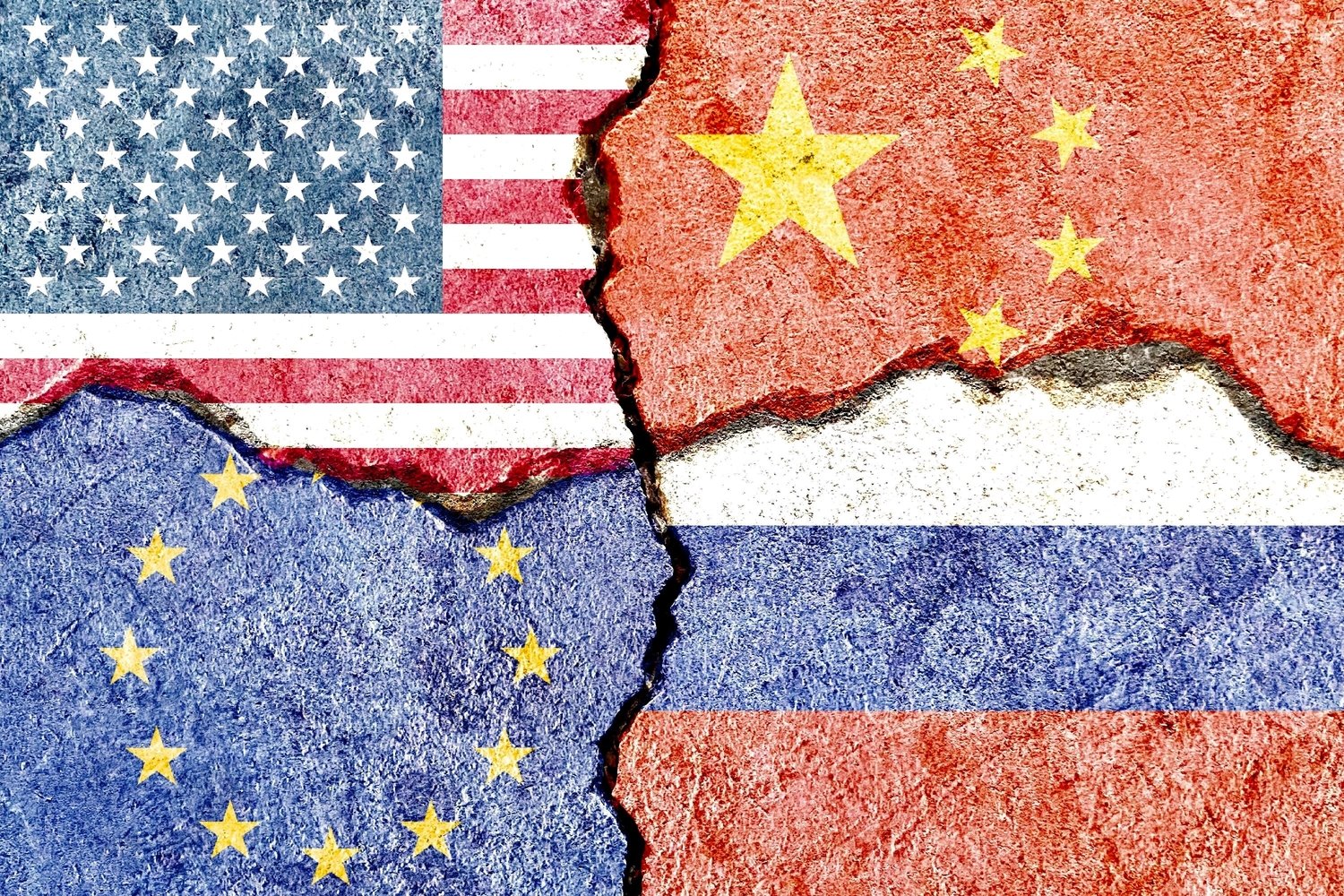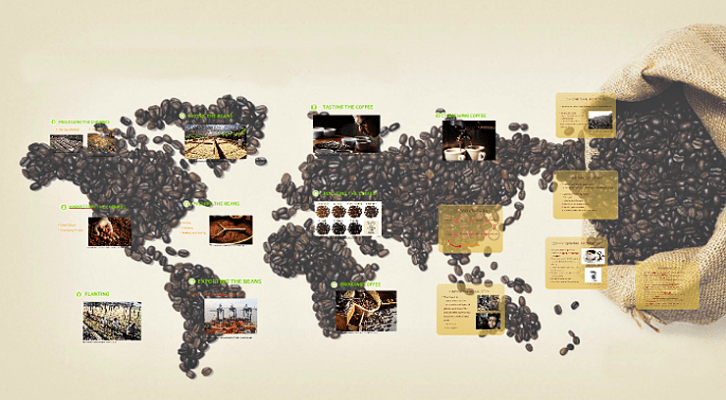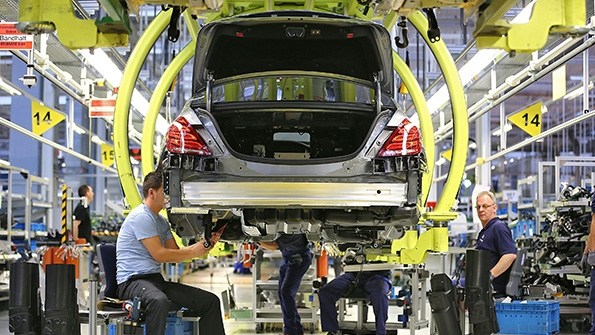Introduction
Donald Clelland is an American sociologist with over 30 years of research and teaching experience, yet with a fairly small number of published works covering the subject of World-Systems Analysis. His existing works and drafts published over the last decade bring the World-Systems Analysis back to its radical roots basing itself on new research.
Clelland’s main subjects cover analysis of commodity chains with a special focus on the role of female labour. Due to this feminist perspective, he refers to commodity chains as Gendered commodity chains.
Although it has the word “chain” in its name, commodity chains are in fact networks of production consisting of a number of geographically distributed producers, each of whom produces a single component of the final product. Every producer in the network is a node, and the distribution of nodes forms a hierarchy akin to core-periphery relationship. For example, the producers of raw materials are to be found in the lowest part of the production hierarchy, just as they happen to be on the periphery of the world-system. Above them are the producers that process the raw materials, then those who produce individual components, followed by the ones that assemble the components into final product that is delivered to the company on top of the hierarchy that maintains control over the commodity chain, owns the final product and markets it. This company is typically a corporation based in a core country.
Clelland focuses on the process of creation of value in each node and its transfer to the last node in the chain. For this reason, he describes commodity chains as surplus extraction chains. This question had been posed by Wallerstein in the 70s when he first formulated the concept of commodity chains.
The key elements of his analysis are:
- surplus drain,
- bright value, and
- dark value.
Surplus Drain
Economic Surplus
Although Marxism is one of the foundations of the World-Systems Analysis, its theorists often criticise and modify Marx’s economic model. That is also the case with Clelland who presents his theory of surplus drain through modification of Marx’s labour theory of value.
Marx’s model supposes that the source of surplus value is to be found in the difference between the value created by the worker and the value of reproduction of his labour force. The logical outcome of that assumption is that the wage covers the costs of survival of the worker and his family. Yet, this does not correspond to the existing situation in the periphery where labour is not completely proletarianised.
As an alternative to Marx’s model, Clelland uses Baran’s and Sweezy’s concept of economic surplus. Baran’s definition of surplus is shortly: “The difference between what society produces and the costs of producing it.” Baran’s concept of surplus is not to be mixed up with Marx’s concept of surplus value: economic surplus is a part of the surplus value that is being accumulated, hence it does not include capitalist consumption, state expenses for administration, defence, repressive apparatus, etc. Defined in such a way, this concept is more flexible as it allows for analysis of additional cases which do not fit into the classic model that Marx devised. For example: unpaid labour, underpaid labour, ecological degradation as a source of value, etc. It would be wrong to claim that Marx did not contemplate those cases, however he did not include them into his abstract model as he considered them to be precapitalist features.
Degree of Monopoly
Second dimension of the criticism of Marx’s model refers to the supposition about the free market exchange. Much like Smith’s classic model, Marx too bases his theory on free market relations without external influences such as state intervention and monopolies.
Clelland considers that the main tendency of the capitalists is not the increase of exploitation but the increase in the degree of monopoly (deviation from the free market).
Degree of monopoly is defined as any kind of mechanism which lowers the price of production or increases the sales price in comparison to free market. Degree of monopoly is present in every node of a commodity chain, and its efficiency is directly related to the position of the node in the hierarchy of the chain. Within every node unpaid value is drained and moved upstream in the chain.
Observed from another perspective, the degree of monopoly could be understood as a capacity of an enterprise to transfer its costs to the enterprises lower down the chain.
Degree of monopoly as we have it today in commodity chains is mainly a degree of oligopsony. Oligopsony is a situation on the market characterised by a small number of buyers and a large number of sellers. This situation allows buyers to lower the price of commodities by leveraging the competition between the sellers. That is, the degree of oligopsony allows buyers to control the prices.
The Importance of Surplus Drain
Surplus drain as a concept is akin to unequal exchange, although it is used in a winder sense and it can be applied to precapitalist systems.
Surplus drain is considered to be a basis of every world-system. Hence, the core-periphery relationship is also defined as a relationship of surplus drain – the zone which creates value but is unable to retain it, is the periphery, while the zone which captures the value is the core. Semi-periphery can be understood as a proxy which drains the value from periphery, while it is itself being drained of value by the core.
Therefore, the division of world into core-periphery zones according to the World-Systems Analysis is neither geographic nor nation-bound, it is a division which reflects the flow of surplus.
In the precapitalist systems, surplus drain was effected by forceful appropriation, or what Marx called “primary accumulation”. Modern, capitalist world-system has two characteristics regarding surplus drain:
- it is effected via commodity by realising production and distribution through different zones of the system, and
- the system has to expand in order to sustain its growth and survival, and that is achieved by searching for new locations with lower prices. (Clelland, 2012)
Surplus drain is one of the mechanisms which reproduces the core-periphery hierarchy and the capitalist world-system itself. At the same time, surplus drain not only allows increased accumulation of profit for the capitalists, but it also makes subsidies for the consumers possible by lowering the final price of the product.
Two Categories of Value
To explain the concept of value, Clelland uses the analogy from the world of physics which considers that 90% of the matter is invisible. According to this analogy, the biggest portion of value is not officially accounted for. It is not a terminology one would come across in World-Systems Analysis, rather a way for Clelland to illustrate the transfer of value.
Value is categorised as bright and dark depending upon it being registered or not in the accounting books. Namely, the capitalists run their accounting in conformity with the information they need for efficient business management. In this respect, they do not account for costs which are not closely related to production. In other words, they do not register externalised costs – the costs borne by someone else even though they should be borne by the capitalist. Unregistered costs are invisible, dark value.
Bright Value
The mechanisms of bright value drain are:
- export of capital (FDI) which enables the repatriation of profit to the country of origin;
- system of monopolies to bypass the competitive market;
- monopolistic control through patents and intellectual property;
- expats in the peripheral countries who send their earnings back to their home country or they buy luxury items from their country of origin, and
- debt slavery – loans which, in spite of being paid over and over, keep being serviced due to accumulated interests.
Additional mechanisms include: capital flight – when comprador bourgeoisie transfer their personal wealth to the core countries; foreign exchange manipulation – devaluation of local currency which reduces the income from imports; portfolio investments – transfer of dividends from periphery to core, among others.
Dark Value
Clelland considers dark value to be present in all factors of production: capital, labour, land, natural resources, knowledge, and energy. Dark value is being realised through ownership over each component in the production chain under its price on the world market.
Dark value is hidden in the way it subsidises commodity chains:
- formal labour paid under the market price;
- commodity inputs to commodity chains which are paid under the market price, and they originate from the household labour in the informal market;
- cheap natural resources, and
- ecological and human externalities which are free for the capitalist (such as unpaid labour, ecological degradation, etc.).
Characteristics of dark value are:
- surplus drain is free for the capitalist, hence, as it is not a cost it is not accounted for in the official registers;
- unaccounted surplus can be converted into accounted surplus (bright value) either by being transformed into profit to the benefit of the capitalists, or it can be transferred into lower prices to the benefit of the consumers;
- the economic significance of dark value grows over time which is why it’s transfer has to expand with the increase of trade volume. In that case, the increase in consumption is what triggers dark value drain from the periphery.
In the context of knowledge and natural resources as a source of dark value, we can name two examples:
- By the means of transnational flow of labour and brain drain from periphery to core, the costs of training and reproduction of the labour force is externalised to the periphery.
- By controlling the ecosystem of the periphery, the core exercises the so called ecologically unequal exchange. The core maintains low price of the raw materials through ownership of their sources. The effects of the uncompensated ecological damage are borne by the peripheral communities via health risks, loss of access to resources for food and costs for rehabilitation of the ecosystem.
Labour as Source of Dark Value
The contribution of labour to the value of commodity consists of the total hours of work – both accounted and unaccounted (i.e. paid and unpaid)–which are realised in the production, including the work on reproduction of the labour force.
Unpaid Labour
Household labour and household resources subsidise the income of the peripheral workers allowing capitalists to pay them wages below subsistence level. The essential characteristic of semi-proletarian households is their capacity to survive via unpaid labour, which is what lowers the price of their labour force in the market.
Unpaid labour of semi-proletarian households has 4 forms:
- capitalists do not bear the costs for the biological reproduction of women, nor for the upbringing of the new generation of workers;
- households engage with an array of unpaid activities for survival which indirectly subsidise capitalists, i.e. collection of unpaid resources;
- women and female children provide unpaid labour in form of support to the male-owned household-based business, and
- women provide unpaid labour for search and use of capitalist products.
From the standpoint of the capital, households are commodity producers: they produce labour force. As such, households are the basis of capitalist production.
Informal Sector
Commodity chains include horizontal chains of small commodity production based on informal sector and non-waged labour. They provide cheap labour, services and inputs for commodity chains below market price. They are also based on semi-proletarian households.
An example of this relationship is a female worker who works in a factory but also employs a caregiver from informal sector to provide care for her child while she’s at work.
Consequences of the Surplus Drain
Consumers in the Core and Dark Value
As mentioned previously, dark value is based upon uncompensated labour or underpaid labour. If production were to be carried out in the core, the final price would be significantly higher. Consumers in the core enjoy the benefits of the exploitation of the periphery through the lower prices provided by dark value.
Social consequences are reflected in the maintenance of the high living standard in the core by the means of high consumption in spite of the decrease in social spending and salary levels. In such a manner, neoliberal reforms counter the effect of lowering real wages by providing cheap imports.
Core-Periphery and Dependence
Surplus drain is super-exploitation of peripheral labour, households and ecological resources which blocks economic growth through investments and expanded production by depriving periphery of its surplus.
On the other hand, dark value drain is also a threat to the ecological sustainability and quality of life of the workers in the periphery, especially that of women.
Surplus drain from the periphery represents a big portion of its economic wealth, but it doesn’t mean a big increase of wealth in the core because the biggest portion of trade is carried out among core countries.
Commodity-Chain Analysis
Let us reformulate the analysis of commodity chains. Commodity chains are exploitative structural relations which occur in the arrays of unequal exchange between its nodes and across world-system zones. Powerful companies use degree of monopoly within the commodity chain to capture bright and dark value.
The cost structure of each node is as follows:
| raw materials |
Value added |
| production costs |
| management |
| overhead costs |
| profit |
Value captured |
| Total: sales price |
Every following node in the array takes the price of the component from the previous chain as the first item in the cost structure. Values calculated this way constitute bright value. In parallel, each node contains dark value in form of externalities. For example: by lowering the wages, the unpaid portion of the created value is captured as profit – i.e. the cost is externalised onto the worker who has to work additional hours in order to earn the wage that covers his subsistence costs.
In a purely competitive system dark value capture would quickly become universal. However, in the monopoly capitalism, the dark value can be leveraged in 3 ways:
- to lower the product price in relation to the price of the competition;
- to expand the accumulation by converting dark value in bright value (reinvestment), and
- as a protection from competition via degree of monopoly.
Enterprises achieve the degree of monopoly via: scale, tariff and non-tariff barriers to protect access to the market, innovation, intellectual rights, marketing… and via monopsonic conditions. Monopsony allows for unequal relations between the participants in the chain. Hence, it allows for surplus drain via unequal exchange.
Clelland reached his conclusions by applying the existing theory on Apple’s commodity chain:
In the capitalist world, Apple is the prime example of an enterprise that perfected commodity chain management becoming a model for other companies. Its model is fabless (without owning a factory) which outsources the whole production process to individual component suppliers and producers which assembles them. On top of the chain, Apple designs the product, controls the production process, coordinates it, manages marketing, logistics and sales.
The way Apple carries out its degree of monopoly is via: innovation, intellectual property, oligopoly relations with the producers in the commodity chain, and externalisation of costs onto them. Apart from the products themselves, the innovation is also to be found in the control of the production process, selection of component suppliers etc. However, innovation alone is not enough. What is also required to ensure monopoly conditions is the legal protection (intellectual property and patents), strict control over the production process and quality control.
The buyer, Apple in this case, encourages competition between suppliers by hiring multiple producers of the same component. At the same time, it keeps searching for new ones who could deliver the component at a lower price. In this way the “non-competitive” suppliers are eliminated from the chain, and on the other hand, pressure is applied by the means of competition in order to prevent the increase of component prices. As a result, the suppliers are forced to drive their costs down and externalise them onto their own suppliers in the lower instances of the chain (for example, suppliers of raw materials, informal sectors, households, etc.).
Finally, Apple provides credit lines for the suppliers. The credits are conditioned by long-term obligations which provide: raw materials below market price, transfer of risk over to suppliers and long-term use of the suppliers’ labour force.
Reference:
Amin, Samir, 1974. “Accumulation on a World Scale: A Critique of the Theory of Underdevelopment”
Baran, Paul, 1957. “The Political Economy of Growth”
Baran, Paul and Sweezy, Paul, 1966. “Monopoly Capital: An Essay on the American Economic and Social Order”
Clelland, Donald, “Surplus Drain versus the Labor Theory of Value”
—, 2012.”Surplus Drain and Dark Value in the Modern World-System”
—, 2014. “Unpaid Labor as Dark Value in Global Commodity Chains”
—, 2015. “The Core of the Apple:Dark Value and Degrees of Monopoly in Global Commodity Chains”
Emmanuel, Arghiri, 1972. “Unequal Exchange: A Study of the Imperialism of Trade”
Wallerstein, immanuel, 1974. “The Modern World-System I”












